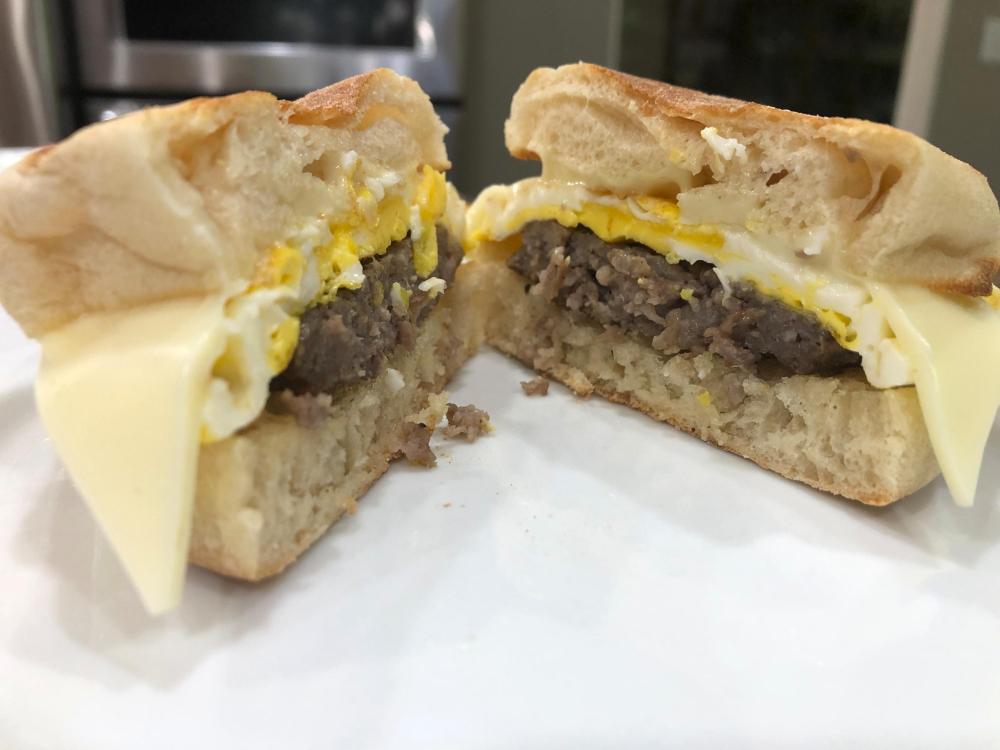-
Posts
1,625 -
Joined
-
Last visited
Content Type
Profiles
Forums
Store
Help Articles
Everything posted by AlaMoi
-
the very nature of how panettone is made/baked/cooled . . . the paper wrap is just simply "there" one can attempt to peel it off 'all at once' - or one can simply 'do the slice' and peel the paper wrap one slice at a time. I do the slice-then-peel. but that's just me.
-
post me about it . . . sitting here, looking at the kitchen area, contemplating where/how I could put in additional shelves/storage . . . I do woodworking, got many mill sawed boards all stickered up and ready for use . . . I'm sensing all my ideas will begone by DW 'what?' . . .
-
parchment paper is 'porous' and will make moist 'crusts' stick. plastic or oiled parchment will avoid the sticking issue.
-
awww, tell me they didn't fib (again).....
-
every Better Than Bullion product I have tried - pork/beef/chicken - including their touted 'lower sodium' / half / less / 'whatever' has been so high in salt . . . it is to gag. I've thrown it all out.
-
the usual shortbread recipes have enough butter that lining or greasing the pan is not required. I suppose somebody made shortbread 'more healthier' hence it many need lining/greasing . . . ?
-
-
there is a plethora of wireless thermometers and associated "apps" on the market. recently saw one that offered four probes, and smart phone 'tracking' of all four simultaneously.... sounds like a potential solution to the problem? just be sure to read the reviews. issues of connectivity reliability, range, "obstructions" are all factors in how happy users are with their gadgets . . . I "graph" the temps 'the old fashion way' - i.e. I read the (exterior) probe display, plunk it into an Excel chart . . . a smart phone app that would seamlessly do all that , , , could be a valuable doohickey....
-
I'd post something, but I'm really too busy munching on DW's current (#3 of four) cookie batch. she does a really mean Christmas cookie spread . . . !
-
heehee - that pretty much what McDonalds offers as "egg mcmuffin with sausage" my home spun version - English muffin vs fine crumb roll....
-
luckier is better . . . this is a very interesting question. sometimes I think 'the results' are highly dependent on "unspecified prior things" huh? example... after two days of 'high end home cookery' followed by dinner with super-evolved/sauced/etc fish dishes . . . browned some ground beef, added Classico chunky pasta/tomato sauce, heated, cooled, reheated next day. over spaghetti, with fresh shredded parm.... like, dude, stunning. plain, simple, delicious.... there is absolutely no magic involved in browning beef or boiling spaghetti - must just be "perceptions" ?
-
using a cake pan, a square cornbread type dish, cupcakes, bread pans . . . the heat penetrates the sides, the batter / dough sets up 'faster' than in the middle. when set, the edges do not "rise" as the center puffs up - from yeast and/or baking powder and/or baking soda and or eggs.
-
you may be particularly sensitive to certain tastes. the most famous "sensitivity" is probably cilantro - to some it tastes like soap... me included.... I have a similar issue with aluminum based baking powders. that metallic twang comes right thru! if you have an iodine deficiency - that takes a Dr. and some blood work - that needs to be addressed with supplements/diet. lacking a known iodine deficiency you can switch to kosher salt / other sea salts - some of which will have trace iodine, but not to the additive level. we haven't used iodized salt in 40+ years - we're pretty light on salt anyway - most resto food generally elicits a 'too salty' reaction.
-
the 'in oven probe' I put in the classic 'thickest part of the breast at the leg area' as it nears done, I check with the insta-read. my method is simply to check multiple places - if I see wildly 'off' temp one can be pretty sure one poked in a 'goofy' spot. 2-3 spots midway down the breast - neck to tail. the leg is the trickiest - because the tendons/etc limit one's choice of 'spots I wanna' check' if the bird has been trussed, checking the thigh is pretty easy. I go straight into the stuffed cavity, the length of the probe . . . if you present the bird, then take it to the kitchen for carving . . . my trick is to wrench off both legs and put them back in a hot oven on a rack for best circulation - bringing the dark meat up to a full 160'F temp while carving . . .
-
I have one with a probe that stays in the bird and a cable to the readout/alarm box. I graph the temps - which allows much better control of when the bird will finish. as it gets close, I use an insta-read thermometer - checking in various places white/dark/thick/thin/stuffing to fine tune "it's done" Thanksgiving DinnerPlan.pdf
-
"classically" focaccia is a sorta' flat bread with an open crumb - using various "seasonings" but definitions only invite deviations - and imho - if a bread tastes good - just eat it, and enjoy! not much different than "pizza" - go to up/down/east/west Italy - you'll find a wild variation of what is baked/sold/eaten as "pizza" - they're all good. forget the name, enjoy the pizza! feel free to have your own preference(s)
-
the sorta' popular theory that one needs a 3000 degree "oven" to cook a pizza is over-rated . . . .
-

Help! I've lost my cooking mojo and I want it back!
AlaMoi replied to a topic in Food Traditions & Culture
as cited by various members in this thread . . . when life whammies you with unpleasant situations . . . one's focus does shift, and it is not at all unreasonable that 'putting effort & care' into cooking will settle to the bottom of one's priorities. after getting tossed on the trash heap of the aged out un-employable . . . I started working (independently) from home, and had time to devote to honing my cooking skills. my motivation is very simple - to have really delicious stuff to eat. and likely most of that motivation is making my DearWife happy. losing a spouse/SO through death/other is devastating enough - as a de-motivating factor to cooking . . . it is a huge factor. cooking-for-one, why? I can survive on hot dogs, hard boiled eggs . . and frozen entries . . . I have done remote "assignments" for months and months - living alone. there is very minuscule motivation to do anything 'above and beyond' absent external factors, I think the increase/decrease of 'man am I gonna' cook this up' feelings is quite natural. it happens. the pendulum will swing . . . and I'll be making oysters Rockefeller right quick, again . . . -
-
baking soda reacting the 'the same amount' of acid will give up about twice as much CO2. in big broad brush strokes,,, denser batters often use baking soda (e.g. Irish soda bread) - or a combination of both. certainly with experimentation you could find how much baking soda is need for a specific recipe - I think the baking powder brings more reliability to the baking.
-
there are recipes that use both baking powder and baking soda. most baking powder is 'double acting' - first the acid-base chemical reaction, then co2 released at higher temperatures. unless you have accurate equipment to measure the pH and acid availability, plus a microgram scale to weigh out the baking soda, , , it's a bit tricky to match up the quantities exactly. then, not all milk/buttermilk/acid ingredient/etc is consistent from batch to batch . . . meaning you might have to test each carton/container/whatever each time you do the bake. I think mos use baking powder for the simplicity and reliable results. too much baking soda can indeed affect the taste of things - so there's little room for 'error on the side of caution'
-
tonight , , , Chesapeake Bay blue-claw crab cakes . . crab+minced shallot+minced celery+double sprinkling of Old Bay brought together with beaten egg and a touch of panko
-

ISO container into which goes a quarter sheet pan plus couple grids/racks
AlaMoi replied to a topic in Kitchen Consumer
for the oven racks, used a pet cage tray from Tractor Supply. pet stores/etc have a variety of sturdy shallow trays in many sizes. -

Hello from MorningGloryFarms on Martha's Vineyard!
AlaMoi replied to a topic in Welcome Our New Members!
""* A gathering of food trucks? 😄"" generically, a 'truckemup' but for this case, a 'fruckemup' -
ah , , , it's such a thing. anyone have a count of haw many bakeries produce a panettone for the season? a while back, there was a video of an Italian guy rating the various brands. his choices of "best" - Maina & Balocco mediumish: Pauluani, Melegatti, Motta okay, all well and good. a local super Mediterranean fish place had La Cascina at check out. it was very good - nada complaint.... so be careful of 'the experts'







